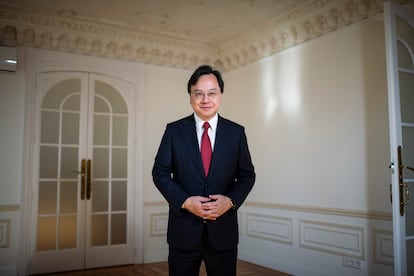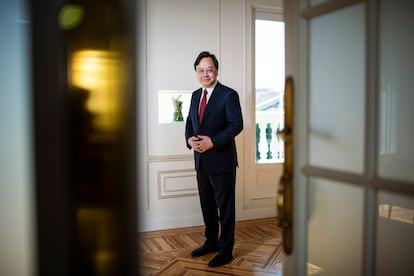Dennis Lo, molecular biologist: ‘There is an exchange of genetic information between the baby and the mother’
The father of noninvasive prenatal diagnosis and pioneer of the liquid biopsy in detecting cancer has changed the way that Down syndrome is identified before birth

“Conventional thinking is that the blood circulation of mothers and babies are separate and that their exchange of materials is limited to nutrients that the mother gives the baby,” says Dennis Lo, 60. The Hong Kong researcher explains that his findings showed that such interactions were much more intimate. “There is an exchange of genetic information between baby and mother,” he says.
Since 1997, Lo has searched for fetal DNA in the blood of pregnant women and developed techniques to analyze and be able to detect illness before birth. His work allowed him to develop a noninvasive test for the identification of Down syndrome, a condition that until that moment could only be detected with techniques that could put the life of the fetus at risk. His technology was launched in 2011 and has changed the practice of prenatal diagnosis, reducing the need for invasive tests.
This week, Lo visited Madrid to receive the Conchita Rábago de Jiménez Díaz Foundation’s memorial lecture award in recognition of his investigative work. The Chinese University of Hong Kong professor is also one of the world’s leaders in the development of liquid biopsy, a technique that makes it possible to diagnose tumors via a blood test.
Question. In addition to detecting chromosome alternations like Down syndrome, prenatal diagnostic techniques can obtain DNA in order to sequence the baby’s whole genome. Could that be useful in preventing illness?
Answer. Work has been done that demonstrates that it is possible to get the whole genome, but people use that technique for more selective purposes. If you have a number of genetic diseases that you want to test for, they use that technology. In the United Kingdom’s NHS, they have a service like that. But if you’re talking about a whole genome, that is something that we have to discuss and debate. I personally think that during pregnancy, the mother has already got a lot of things to worry about, so we should not overburden her with information that she doesn’t need at that time. The information she needs is whether a baby may be suffering from some life-threatening disease which will take effect during pregnancy or immediately after.
If you’re talking about a whole genome, there might be information about the baby’s health in a distant future. I don’t think the mother needs to know that her baby may have a high chance of developing diabetes 40 years from now. Also, our knowledge of the genome is not perfect. It’s also possible that if you just see the whole genome and you don’t know what it means, that could worry the mother as well. So, I think at the moment, it’s best to limit this information to looking for important and early diseases.
Q. Would it be interesting to combine the information that is offered by prenatal diagnosis to identify genetic illnesses with gene editing techniques that allow us to correct them?
A. Currently, ethical and legal guidelines say that you cannot change a baby in such a way that the change could be inherited by future generations. You have probably read about the case of a Chinese scientist who modified the genome of a number of babies for HIV resistance. That case has been globally condemned and there are still debates on whether, apart from conferring HIV resistance, that sort of change might have other effects on those babies later on in life, perhaps making them more susceptible to other viral infection. That being said, when this Chinese scientist did this genome editing, he actually did use the noninvasive prenatal testing (NIPT) to tell whether his editing had worked.

Q. Nowadays there are still tumors, such as those in the lung or pancreas, that are frequently detected too late. Is it possible that liquid biopsies could change that situation?
A. There are tests for just one type of cancer and others for multiple types. Among those that are for one type of cancer, I have developed one for cancer of the head and neck. For one kind of tumor, it is easier to do clinical trials because you have just one cancer and high-risk group. In that case, results can be impressive. In Hong Kong, I have focused on nasopharyngeal cancer, which is very common in the southern part of China. A Cantonese man like me has a lifetime risk of one in 39 for having this cancer. What we’ve done is to use the liquid biopsy test to screen for this cancer, and we find that if you don’t screen, around 75% of the cases are detected in stage three or four [very advanced], but if you screen, then 70% of cases are discovered in stage one or two, and can be treated early. The survival rate is actually improved by 10 times, a big improvement. We published this paper in the New England Journal of Medicine in 2017, and now we’re actually implementing this technology in Hong Kong.
To analyze many kinds of cancer, as each cancer has different genomic changes, it is difficult to screen for all kinds of tumors, which each have their own mutations. What we’ve developed is a test which looks at epigenetic change. Epigenetics is when the DNA sequence does not change, but the formatting of the sequence changes. What is interesting is that different organs in the body have different formatting, so [due to that formatting] you can tell where the cancer is. A few years ago, we developed this technology, which has now been licensed to Grail [a company] of which I was a scientific co-founder. Grail now has a test for 50 types of cancer. According to the latest data that they published, if the test is positive, the chance of a person having cancer in that moment is 75%. If it is negative, then the chance of that person having cancer at that moment is 2.5%. And they can tell you where the cancer is with 86% accuracy. The current weakness of that test is that in stage one cancer, the sensibility is about 25%. Stage two is about 57%. And so, we still have to improve.
Q. Couldn’t so much information generate stress, make us feel like we are sick before we are sick, waiting for doctors to detect that we have cancer?
A. I think that health education and the ability of the health system to follow people and treat them appropriately is important to take the stress away. If you have a technology that detects a risk, but you can’t treat it, it’s useless, but we can see what happens with blood clots, with cholesterol. Many people, especially those who are middle-aged and beyond, have those, but they take medications to control the issue and they’re not worried. They take their statins and get regular follow-ups. With cancer, it would be something like that.
Q. Could liquid biopsies also be used to better monitor the treatment of a disease?
A. The idea of a liquid biopsy is that the blood will absorb DNA from various parts of the body, so it’s basically a mixture of all the things that give you a more global view of what’s happening in the body at a particular time. It allows you to look at multiple clones of a tumor at the same time and see how it evolves and adapts to treatment. In lung cancer, there is a gene called epidermal growth factor receptor (EGFR) and if you have EGFR mutation, then you can treat the tumor with a class of drugs called tyrosine kinase inhibitor. When the tumor cell evolves, it will develop resistance mutation and then you will see more DNA circulating in the blood.
Sign up for our weekly newsletter to get more English-language news coverage from EL PAÍS USA Edition
Tu suscripción se está usando en otro dispositivo
¿Quieres añadir otro usuario a tu suscripción?
Si continúas leyendo en este dispositivo, no se podrá leer en el otro.
FlechaTu suscripción se está usando en otro dispositivo y solo puedes acceder a EL PAÍS desde un dispositivo a la vez.
Si quieres compartir tu cuenta, cambia tu suscripción a la modalidad Premium, así podrás añadir otro usuario. Cada uno accederá con su propia cuenta de email, lo que os permitirá personalizar vuestra experiencia en EL PAÍS.
¿Tienes una suscripción de empresa? Accede aquí para contratar más cuentas.
En el caso de no saber quién está usando tu cuenta, te recomendamos cambiar tu contraseña aquí.
Si decides continuar compartiendo tu cuenta, este mensaje se mostrará en tu dispositivo y en el de la otra persona que está usando tu cuenta de forma indefinida, afectando a tu experiencia de lectura. Puedes consultar aquí los términos y condiciones de la suscripción digital.
More information
Archived In
Últimas noticias
Welcome to the post-religion era: The idea of Christianity as the absolute truth has become obsolete
‘I thought you would like it’: The risky sexual practice popularized by TV shows and TikTok
The digitalization of tourism: ‘They promise experiences and gave us the worst possible one’
Mexican peso defies uncertainty with forecasts of a new period of stability in 2026
Most viewed
- Sinaloa Cartel war is taking its toll on Los Chapitos
- Reinhard Genzel, Nobel laureate in physics: ‘One-minute videos will never give you the truth’
- Oona Chaplin: ‘I told James Cameron that I was living in a treehouse and starting a permaculture project with a friend’
- Why the price of coffee has skyrocketed: from Brazilian plantations to specialty coffee houses
- Silver prices are going crazy: This is what’s fueling the rally











































